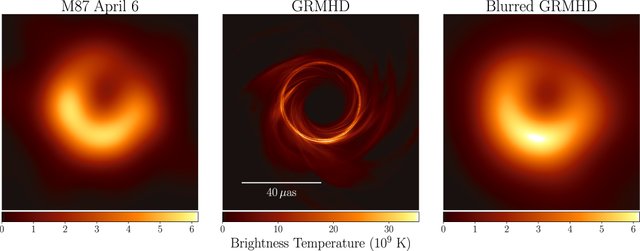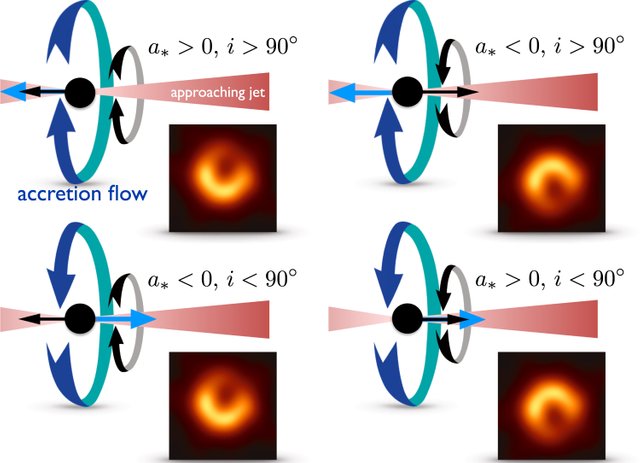Asymmetrical Black Hole Boundary
Today, a press release was conducted by astrophysicists regarding the first ever "image of a black hole."
What is immediately apparent about the image is the asymmetrical ring surrounding the object. In First M87 Event Horizon Telescope Results. V. Physical Origin of the Asymmetric Ring, a Event Horizon Telescope collaboration by Akiyama et al., they attempt to analyze and explain the asymmetrical ring by using various means.
As shown in Figure 5, the crux of the interpretation is that the boundary is moving so quickly that one half experiences a Doppler shift to higher energy due to its motion towards Earth and the other appears less energetic due to its motion away:
The caption reads:
"Figure 5. Illustration of the effect of black hole and disk angular momentum on ring asymmetry. The asymmetry is produced primarily by Doppler beaming: the bright region corresponds to the approaching side. In GRMHD models that fit the data comparatively well, the asymmetry arises in emission generated in the funnel wall. The sense of rotation of both the jet and funnel wall are controlled by the black hole spin. If the black hole spin axis is aligned with the large-scale jet, which points to the right, then the asymmetry implies that the black hole spin is pointing away from Earth (rotation of the black hole is clockwise as viewed from Earth). The blue ribbon arrow shows the sense of disk rotation, and the black ribbon arrow shows black hole spin. Inclination i is defined as the angle between the disk angular momentum vector and the line of sight."
An Analysis of the Asymmetrical Ring With Relationship to Earth
It is worth noting that all systems function the same. When we look at the Earth, we do not say that half of it is brighter than the other half due to the rotation of the atmosphere. Rather, we recognize that the Earth is brighter on one side due to a source of energy radiating on it and making it that way, i.e. the sun.
If this is the case, then the object depicted in the EHT images is not necessarily asymmetrical due to the rotational speed of the surrounding gas, but rather is asymmetrical due to it receiving radiation on one side from its own "sun." This would be an object sufficiently massive so as to produce day and night on an object as massive as a black hole. As this only gives a general direction, going forward it may be the case that we discover these asymmetrical rings to exist and to be able to pinpoint the object lighting half of their body by the direction that we see several of these rings pointing.
This could open an entirely new branch of astronomical analysis, if we were to find correlation between asymmetrical rings and the direction they face. But only if we are even considering such possibilities.
It is worth noting that Doppler Shift is not always the answer to anything we see that we do not understand. We can look to parallels in other layers of the infinite universe to consider other means by which observations may occur rather than staying within the confines of what we anticipate and already believe. Only through this method can we truly uncover the universe as it is, and not as we already see it.


This post has been voted on by the SteemSTEM curation team and voting trail. It is elligible for support from @curie.
If you appreciate the work we are doing, then consider supporting our witness stem.witness. Additional witness support to the curie witness would be appreciated as well.
For additional information please join us on the SteemSTEM discord and to get to know the rest of the community!
Please consider setting @steemstem as a beneficiary to your post to get a stronger support.
Please consider using the steemstem.io app to get a stronger support.